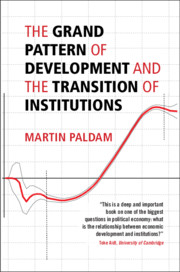Book contents
- The Grand Pattern of Development and the Transition of Institutions
- The Grand Pattern of Development and the Transition of Institutions
- Copyright page
- Contents
- Figures
- Tables
- Preface
- Part I Main Ideas
- Part II The Transitions of Institutions
- Contents
- Part IIA The Democratic Transition
- Contents
- 4 Literature, Data, Transition Path, and Causality
- 5 The Jumps Model for the Short Run
- 6 Events Are Practically Random
- 7 The Three Pillars Model for the Long Run
- Part IIB The Transition of the Economic System
- Part IIC The Transitions in Traditions and Beliefs
- Part III The Grand Transition
- References
- Index
7 - The Three Pillars Model for the Long Run
from Part IIA - The Democratic Transition
Published online by Cambridge University Press: 07 August 2021
- The Grand Pattern of Development and the Transition of Institutions
- The Grand Pattern of Development and the Transition of Institutions
- Copyright page
- Contents
- Figures
- Tables
- Preface
- Part I Main Ideas
- Part II The Transitions of Institutions
- Contents
- Part IIA The Democratic Transition
- Contents
- 4 Literature, Data, Transition Path, and Causality
- 5 The Jumps Model for the Short Run
- 6 Events Are Practically Random
- 7 The Three Pillars Model for the Long Run
- Part IIB The Transition of the Economic System
- Part IIC The Transitions in Traditions and Beliefs
- Part III The Grand Transition
- References
- Index
Summary
The long series for the Polity P-index, 1800–2016, confirms equivalence. The great majority of traditional systems were based on three pillars: (i) a king from a royal house, (ii) a feudal aristocracy, and (iii) a national Church. The Grand Transition undermines two of these pillars: The Agricultural Transition reduces the agricultural sector dramatically. The Religious Transition substantially reduces religiosity and the economic power of the Church. Without the two pillars, the political system must change, and in addition, development creates a large middle class, which is the main recipient of the large increase in human capital. The consequence is very likely to be democracy. This is the strong but fuzzy relation behind the transition curve. The chapter also analyzes the spells of constant systems and explains why political systems consolidate into status quo equilibria that need triggering events to be broken.
Keywords
- Type
- Chapter
- Information
- Publisher: Cambridge University PressPrint publication year: 2021

